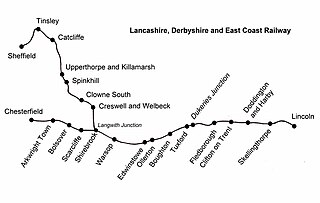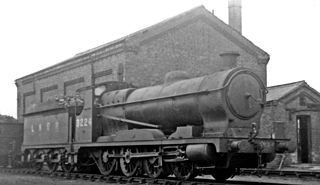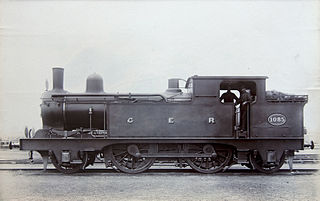The London and North Eastern Railway (LNER) produced several classes of locomotive, mostly to the designs of Nigel Gresley, characterised by a three-cylinder layout with a parallel boiler and round-topped firebox. It produced the most famous locomotive of its day, 4468 'Mallard', the holder of the world steam locomotive speed record. It also built the world-famous 4472 'Flying Scotsman'. However, its locomotive inheritance was much greater than just the 'A4 Class', it also produced highly successful mixed-traffic and freight designs.

The Great Eastern Railway (GER) Class Y14 is a class of 0-6-0 steam locomotive. The LNER classified them J15.

North Eastern Railway (NER) No. 66 Aerolite is a preserved British steam locomotive. It was classified X1 by the LNER. It was capable of reaching 55 mph.

The North Eastern Railway Class T2, classified as Class Q6 by the LNER, is a class of 0-8-0 steam locomotive designed for heavy freight, especially for hauling long coal trains to various collieries in the North Eastern region of the UK, with a maximum speed of 40 miles per hour. 120 were built at Darlington Works and Armstrong Whitworth between 1913 and 1921 to the design of Vincent Raven, based on the NER Class T and T1. The batch of fifty built by Armstrong Whitworth from 1919 were A-W's first locomotives to be built, after the conversion of their Scotswood works from ordnance to peacetime production.

The North Eastern Railway (NER) Class H, classified as Class Y7 by the London and North Eastern Railway (LNER) is a class of 0-4-0T steam locomotives designed for shunting.

The GER Class G58 was a class of 0-6-0 steam tender locomotives designed by James Holden for the Great Eastern Railway in England. The class consisted partly of new locomotives built from 1905 to 1911 and partly of rebuilds of the earlier GER Class F48 built from 1900 to 1903. The rebuilding started under GER auspices from 1921 and was continued by the London and North Eastern Railway (LNER) after grouping in 1923.

The Great Northern Railway Class H2 and H3 was a class of 2-6-0 steam locomotive designed for mixed-traffic work.
The Lancashire, Derbyshire and East Coast Railway (LD&ECR) was built to connect coalfields in Derbyshire and Nottinghamshire with Warrington and a new port on the Lincolnshire coast. It was a huge undertaking, and the company was unable to raise the money to build its line. With the financial help of the Great Eastern Railway it managed to open between Chesterfield and Lincoln with a branch towards Sheffield from 1896. Despite efforts to promote tourist travel, the passenger business was never buoyant, but collieries were connected to the line, at first and in succeeding years. The Great Eastern Railway, and other main line companies, transported coal to the southern counties, and the company's engines took coal to Immingham in great quantities. The company had a fleet of tank engines.

Tuxford Central railway station is a former railway station in Tuxford, Nottinghamshire, England.

The Great Central Railway (GCR) Class 8A was a class of 0-8-0 steam locomotive built between 1902 and 1911 for handling heavy coal trains over the Pennines. They all passed to the LNER in 1923, who redesignated them Class Q4. They were withdrawn from service between 1934 and 1951.
The H&BR Class F2 was a class of 0-6-2T steam locomotives of the Hull and Barnsley Railway. It was designed by Matthew Stirling and nine locomotives were built by Kitson & Co. in 1901.
The H&BR Class F1 was a class of 0-6-2T steam locomotives of the Hull and Barnsley Railway. The locomotives were part of a batch built by Kitson & Co. for the Lancashire, Derbyshire and East Coast Railway (LD&ECR), but the order was cancelled because the LD&ECR was unable to pay for them.

The GCR Class 1B was a class of 2-6-4T (tank) locomotives on the Great Central Railway. They were notable as the first locomotives of the 2-6-4T wheel arrangement to be used by a British standard-gauge railway; there had been two narrow-gauge examples on the Leek & Manifold Valley Light Railway since 1904.
The LD&ECR Class D was a class of nine 0-6-4T steam locomotives supplied to the Lancashire, Derbyshire and East Coast Railway in 1904 and 1906 by Kitson & Co. of Leeds. They later became the property of the Great Central Railway and finally the London and North Eastern Railway, upon which they were known as Class M1.

The GCR Class 2 was derived from a Kitson (Leeds) built/Thomas Parker designed prototype 4-4-0 locomotive No. 561, exhibited in Manchester in 1887. The design lead to the production of a series of express steam locomotives built between 1890 and 1894 for use on the Manchester, Sheffield and Lincolnshire Railway, later the Great Central Railway. The last batch of six, built 1894, had larger bearings for the coupled wheels, coil springs for the driving axle and was classified 2A.
The LD&ECR class B was a class of 0-6-0T steam locomotives of the Lancashire, Derbyshire and East Coast Railway.
The LD&ECR class C was a class of 0-4-4T steam locomotives of the Lancashire, Derbyshire and East Coast Railway.
The GER Class Y65 was a class of twelve 2-4-2T steam locomotives designed by S. D. Holden and built by the company's Stratford Works in 1909–1910. They all passed to the London and North Eastern Railway at the 1923 grouping and received the classification F7.

The GER Class C32 was a class of fifty 2-4-2T steam locomotives designed by James Holden and built by the company's Stratford Works between 1892 and 1902. They all passed to the London and North Eastern Railway at the 1923 grouping and received the classification F3.

The LNWR 18-inch Goods was a class of 310 0-6-0 freight steam locomotives built by the London and North Western Railway at their Crewe Works between 1880 and 1902.











